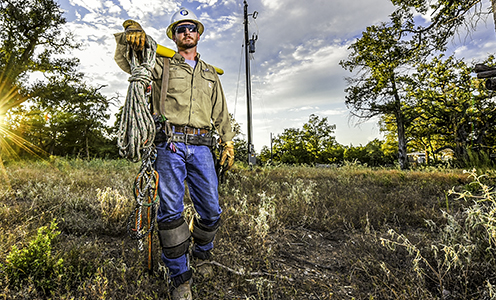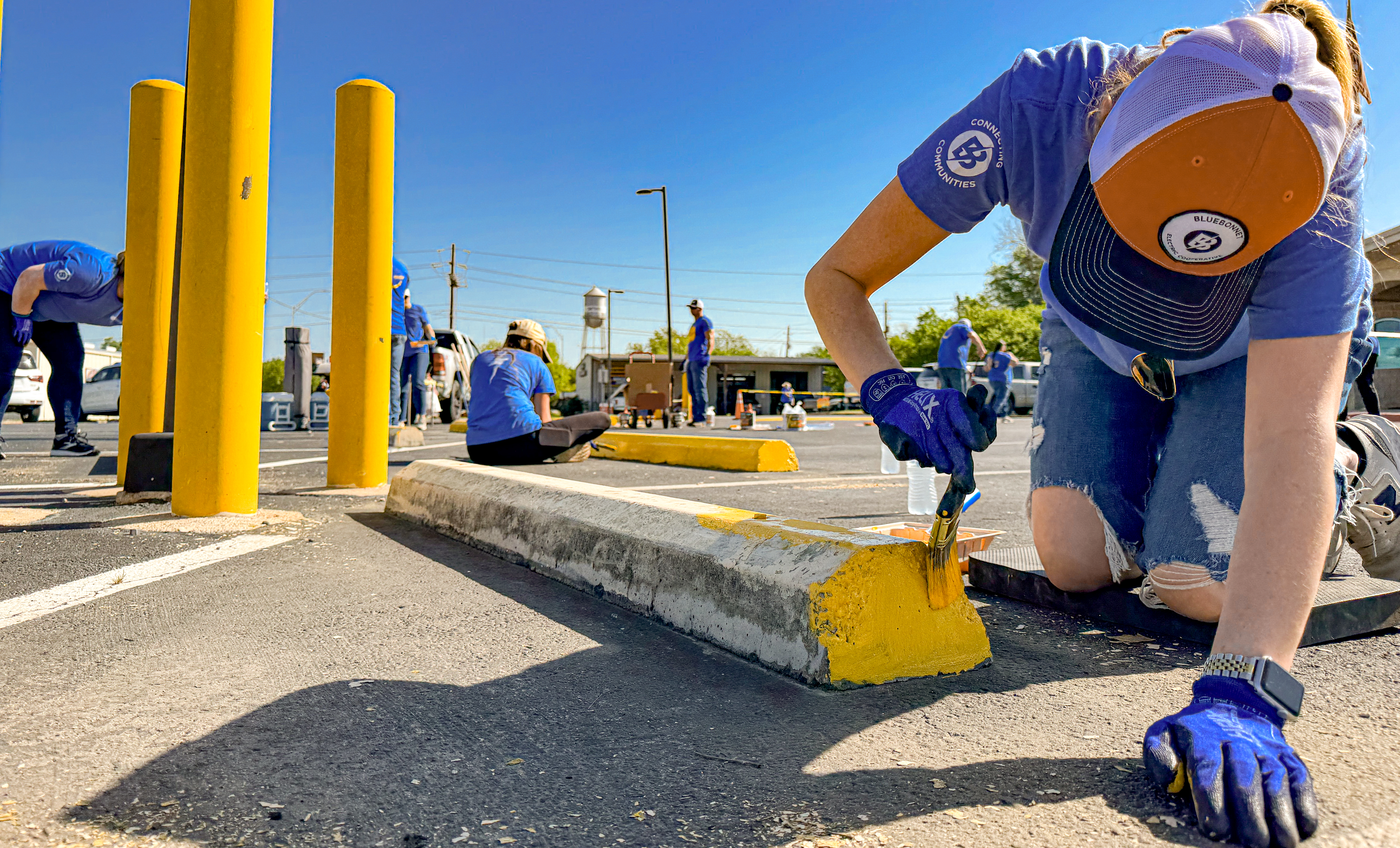Stories of outages, response and restoration — and communication every step of the way
Stories of outages, response and restoration — and communication every step of the way
Story by Kirsten Tyler
Photos by Sarah Beal
Imagine this: It’s night, and a powerful storm is moving through the region. There is thunder and lightning. Your lights flicker once, twice, a third time. Then, darkness. As you reach for your phone to report the outage, Bluebonnet Electric Cooperative’s control center operators are standing by to take the first steps to restore your power.
Every day, control center operators monitor more than 138,000 meters spread across 12,000 miles of power lines. They notify lineworker crews and member service representatives when power outages occur. All day and night, teams work until your and your neighbors’ electric service is restored.
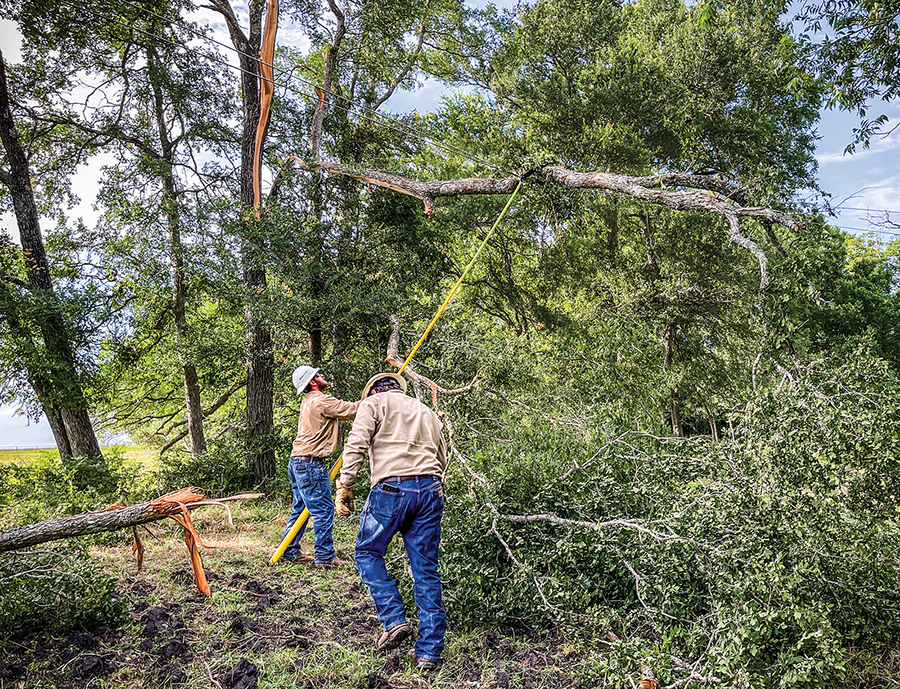
The members — Jeanne and Wiley Mathis

Bluebonnet members Jeanne and Wiley Mathis have lived at Kick Back Ranch on Geers Road in Brenham since 2007. Several family members — Jeanne’s two sisters and the couple’s niece — also live nearby. On May 16, 2024, a powerful “derecho” storm swept through Central Texas. Derecho is Spanish for “straight ahead,” a reference to this type of storm’s wide swath of straight-line winds, which on this day were measured at 60 to 100 mph. The destructive wind and lightning knocked out power to the Mathises. Those outages are representative of the hundreds of other outages in the Bluebonnet service area caused by this storm.
Jeanne Mathis knows what to do when electricity goes out: watch for texts from Bluebonnet about her outage, check in with neighbors and look at Bluebonnet's online outage map for more information.
During the May storm, she called Bluebonnet directly to report the outage. “Bluebonnet’s service has always been great, and the member service representative I spoke with was knowledgeable and congenial,” Jeanne said.
During the outage, the family remained at home and waited out the storm to care for their livestock and cats. The “derecho” developed in West Texas. It increased in strength as it swept through Central Texas and caused the most severe damage in Washington and Austin counties. Trees were uprooted and twisted, ripping down power lines and breaking poles and crossarms.
Those kinds of outages are the most time-consuming and labor-intensive. They require specially trained and equipped crews to remove trees before power restoration crews can begin to repair or replace equipment and restore members’ power.
Bluebonnet crews were prepared and ready to respond to the massive storm. More than 345 lineworkers, contractors and tree trimmers worked around the clock to repair damage and restore power.
Like many outages during the derecho, the outage at the Mathises’ property was caused by trees falling into power lines. Bluebonnet crews attacked these complex outages across the region, which suffered widespread damage.
Jeanne Mathis received four text messages from Bluebonnet. The messages included information about the trees falling into the power lines that served her home, when crews arrived on location and their progress while repairing the damage.
After her power was restored, she shared a kind message on Bluebonnet’s Facebook page. “Thank you to all the linemen in restoring our power on Geers Road and all the other linemen helping the Brenham area. Job well done!!! Stay safe out there and get back home to your families and loved ones.”
The lineworker — the complex job of restoring power
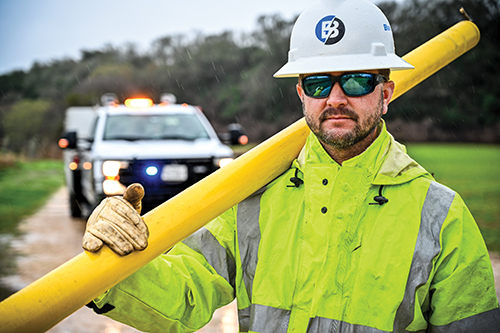
Jeffrey Bolding started at Bluebonnet as a lineworker in 2009. “My brother, Danny, and several others I grew up with worked for Bluebonnet and loved it,” he said. “I figured I would give it a try. I have never looked back because it is a tight, proud, loving and community-oriented organization.”
In the last 16 years, Bolding has worked on challenging outages, from troubleshooting and repairing damaged underground lines to restoring service after tornadoes tore down above-ground power lines and poles. He said it is always rewarding to restore power to members after a storm.
Bolding has plenty of experience working through some of the most destructive weather events in Bluebonnet’s recent history. The weather always factors into what he takes to the job. He packs plenty of snacks and extra clothes — a shirt, pants and two pairs of socks — to change into. Keeping his feet dry and warm inside steel-toe boots is especially important.
For Bluebonnet and other utilities across the state, restoring power during an outage is an all-hands-on-deck effort. Teams work nonstop until power has been restored to all members.
Because of this, Bolding also makes sure his family is prepared. “Every time I am called out, I get a hug and kiss from everyone. They tell me to stay safe and they make sure I have everything I need,” he said. “Often times, packed away with my lunch or in the pockets of my clothes, I find notes and drawings from my family.”
Bolding said the best part of his job is that after working long hours in terrible weather, he goes home to his family, takes a hot shower and sleeps in his own bed. “That is really wonderful,” he said.
Bolding and other lineworkers said they get great satisfaction from hearing members shout with joy once a storm passes and their electricity is restored. “I feel a huge sense of relief. Not only because the power to members was restored, but because I know my crew and my family are safe,” Bolding said.
The communications team — keeping members updated
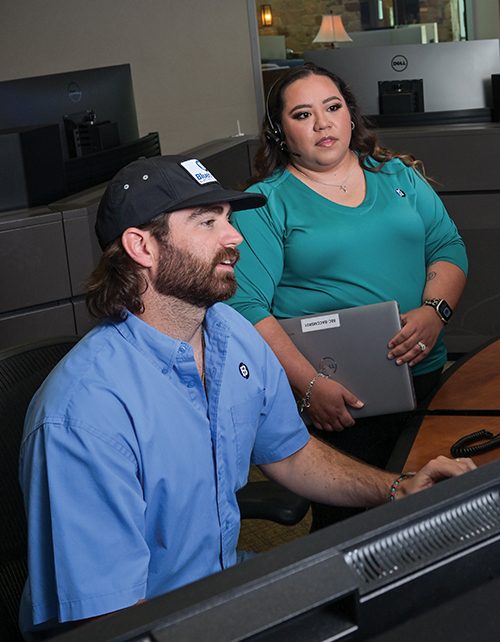
“Whether it’s one member out of power or thousands, we stay in constant contact with the control center to gather details about what caused an outage, what is being done to fix it and how long repairs will take,” said Clarissa Ortiz, part of the team responsible for communicating with Bluebonnet members during outages.
Ortiz joined Bluebonnet in 2016 as a member service representative in Bluebonnet’s Bastrop-based call center. She answers calls from both English- and Spanish-speaking members to connect new service, process bill payments and address any questions about electric service. Since November 2023, she has also been part of the member communications teams that work shifts to send text messages to Bluebonnet members whose power is out.
She and her teammates stay in contact with control center operators through texts and phone calls to get updates about power outages.
“Members want to know when crews are on-site, what caused the outage — whether it was an animal or a car hitting a pole — and when their power will be restored. It is our job to give them those answers as soon as possible,” Ortiz said. “We also let members know if we are still investigating the cause of their outage.”
Communications teams also monitor Bluebonnet’s social media and sometimes call members during smaller or multi-hour outages. During major storms that can cause hundreds of outages across Bluebonnet’s large service area, Ortiz and the team are in the control center, working side-by-side with operators to provide rapid updates to members.
“Every outage is different, and so is the information we send in text messages,” Ortiz said. “We typically determine the cause within 30 minutes of the crew’s arrival. Lineworkers provide the control center with an estimated repair time. Then this information is passed to the communications team to send an update to the members affected.”
One storm was particularly memorable for Ortiz. In July, after Hurricane Beryl affected part of Bluebonnet’s service area, she arrived at the control center at 6 a.m., prepared to work a 12- to 16-hour shift.
“The atmosphere was intense. Phones were ringing, radios crackled with updates and large TV screens displayed maps of outages across Bluebonnet’s area,” she said. “Everyone was locked in and focused to get our members’ power back on.”
Ortiz took a seat in the middle of it, listening closely to conversations between control center operators and field crews. “Every piece of information mattered,” she said.
“We have families, too, so we understand what we would want to hear and strive to tailor our messages to that,” she said.
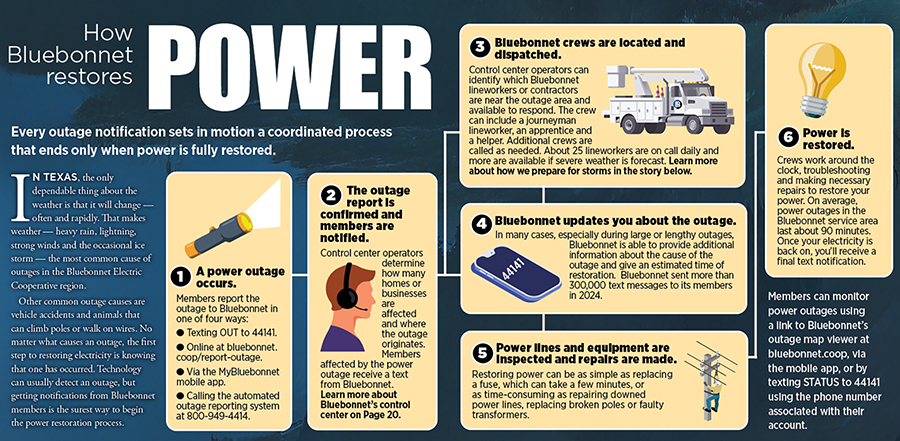
Bluebonnet crews start preparing long before bad weather arrives
When severe weather is headed for Central Texas — regardless of whether it’s a fierce spring thunderstorm, the threat of a tornado, flooding from a hurricane pushing inland or a winter storm that could ice roads and power lines — Bluebonnet Electric Cooperative employees are prepared.
Leadership and operations teams start preparing days and weeks in advance by stocking additional materials, filling fuel tanks, and creating staging areas for crews and contractors.
“Our members deserve and expect the very best service from us, and we take that responsibility seriously,” said Eric Kocian, Bluebonnet’s Chief Engineer and System Operations Officer. “Storms can be unpredictable, but our preparation isn’t. The more planning we do ahead of time, the more efficiently we can restore power.”
If the possibility of long outages looms, contractor crews are notified to be on standby to efficiently support Bluebonnet’s crews. These additional lineworkers, whether from Texas or out of state, are called in based on the anticipated severity of the storm, and staged at service centers and areas where the most damage is expected. The need for these crews is consistently reevaluated as severe weather moves through the cooperative’s service area.
As the storm approaches, Bluebonnet’s operations teams continuously monitor the forecast and provide updates around the clock to ensure a rapid response. Meetings are held to assess the changing situation and adjust crew deployment accordingly. Depending on where the storm impacts Bluebonnet’s 14-county service area, crews are strategically moved across counties to restore power as efficiently as possible.
The fleet and operations teams also prepare specialized equipment, including tracked machines, side-by-side offroad vehicles, snow chains for tire traction and drones to locate storm damage and make necessary repairs.
While preparations vary based on the anticipated size and severity of a storm, some steps are the same for every weather event.
“We show up at the office, gather the other guys on the crew like any other day,” said Logan Lancaster, a lineworker crew supervisor who started at the cooperative’s Giddings service center in 2013. Crews are then assigned to an area or section of line to work on.
“I once worked a storm in the Washington County area, 100 miles from the service center I work out of,” said Joe Lockhart, a Bluebonnet crew supervisor in Maxwell. “Our job is the same regardless of where we work. Our priority is still getting the power on as quickly and safely as possible.”
As soon as conditions are safe, crews are dispatched to assess damage, prioritize critical repairs and restore power as quickly as possible. Lineworkers are in constant contact with crew supervisors, who are always communicating with control center operators.
By ramping up resources before and during storms, all crews can operate on shifts to ensure their safety while restoring power.
“Depending on the type and severity of the storm, we transition to 12-hour shift work and are put on rest when we are not working,” Lancaster said. “It is hard to sleep during the day when the sun is up, especially after working all night, so I try to rest as much as I can to be prepared for storm events.”
No matter the season or severity of the storm, Bluebonnet’s commitment is always to restore power as quickly and safely as possible, and to keep its members informed.
The power of connection
It’s easy to get updates quickly through Bluebonnet outage text alerts.
All cooperative members with a smartphone are automatically enrolled in the outage alerts program and will receive regular text updates on outages affecting them.
If you are a member with a power outage, you will:
- Receive a text whenever an outage occurs at your home or business.
- Get text updates on the status of the outage.
- Receive a final text when your power is restored.
Are you not receiving outage text notifications? Enroll in the program by texting “BBOUTAGE” to 44141 or call member services at 800-842-7708.
Update your contact information
Did you change your phone number? You must update your contact information with your new number in order to receive outage text alerts from Bluebonnet Electric Cooperative.
You can update your number on your online MyBluebonnet account or mobile app. This ensures that Bluebonnet will be able to text you in the event of an outage, maintenance or any other concern.

